Finding
the core of weaving in Tibet is like unravelling a tangled skein. Loosening
and loosening the loops and catches; getting down to the very heart of
the knot, its nub, and seeing it to be but a single strand. The realization
dawns that nothing was ever there. This is the empty ground, the field
of the rug upon which fertile imaginations played.
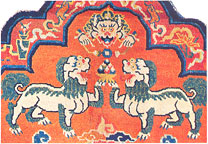 Fig. 1
Fig. 1 |
|
Stylization
is the expression of motif. As in other traditions, the Tibetan weavers
found elements such as the cloud, the flower, and the bird well within
their panorama of stylization. These were taken and adapted to their view,
which in turn has drawn from, and not added to, a tradition already rich
in symbols and their meaning. The types of design found in Tibetan carpets
are of varied origins, yet the geometricals, meanders, repetitive patterns,
and florals retain a flavor peculiar to the Tibetan view. This flavor
or taste was heightened with the advent, especially in the last century,
of Chinese influence in design. Not only were there woven artifacts, but
everything from porcelain teacups to silk brocades gave the Tibetans a
new space in which to place their motifs. It lent inspirational life to
the art that had been .executed in relative isolation for a thousand years.
The space was the element of time. It was the time it takes for a scene
to unfold—for a theme to be grasped. A sense of humor was rediscovered
in the comic strip quality of stylized figures on stage. A new dimension
unfolded.
| |
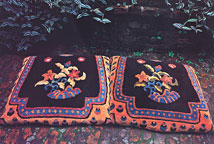 Fig.
2
Fig.
2 |
The motif,
then, can best be grasped by first sensing the surrounding space. The
bat, the lightning, and the mountain take their individual forms within
a scene. The motifs are not arbitrary; they have interrelationships and
their movement produces a sense of time. At least a portion of the , vast
scope of stylization and motif would be at the weaver's fingertips. He
would lend his own touch according to his understanding. The weavers brought
life to the figures they wove—they did not merely follow the dictates
of a rigid stylization. It was in their blood, so to speak. It was the
natural expression of their view.
 Fig.
3
Fig.
3 |
|
So
they wove snowlions dancing on clouds, and on the lion they put a garuda's
head and wings. They wove a crocodile's head on a shellfish, and a fish's
head on a mongoose. With these mythical creatures, their hostile forces
were neutralized. They wove a dragon to speak of power and a phoenix to
extol feminine virtues. They wove human skins and tiger skins to free
egocentric concepts. They wove a ritual vase or a monogram for long life.
Within a single swastika sphere, whole world systems were evolved or created.
Water, wire, and smoke fenced off the corners, and Chinese walls were
sculpted at the perimeters. They sank rocks, planted trees, and wove clouds,
three abreast, either swimming or sitting. They wove crossed scepters
for protection; bells, chains, masks, and a variety of skulls to order.
They wove horses, and rugs for horses. They
wove bats, stags, and a species of native crane. They laid the tracks
with frog prints, arrow heads, and snowflake patterns across the field.
They wove ritual daggers and curved knives to cut off mental projections.
Meanwhile, they let their imaginings roam wild. Even flowers were fantastic.
The average weaver had probably never seen a phoenix, or a lotus, yet
any could give an accurate description.
| |
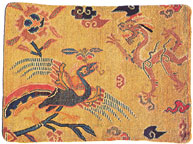 Fig.
4
Fig.
4 |
The snowlion changes
color with age; like turquoise, the mane turns from blue to green. The
dragon will rise at midday and be dark; by dusk it blazes bright. Rarest
are the front facing dragons—the number of toes indicates rank.
It dwells in the earth, water, or sky and may have wings. The dragon grasps
or bestows a precious jewel. Upon this jewel, or norbu, the dragon feeds,
and when it is reflected upon other jewels the sky is filled with lightning.
The sky itself reflects pale emptiness. Clouds, too, communicate in lightning
flashes. Lightning is silver-pink and cold as stainless steel.
Clouds are full
and move with intent across the heavens. The clouds have a dual nature:
they sit as if holding something like a container or they fly without
looking down. Clouds polarize with each other or magnetize to rocks,
their root. The rock has weight and is colored green to black. Mountains
rise from inner fire. Rocks lend a physical presence while clouds indicate
a molecular structure. The bat then is an electronic impulse—they
are messengers beyond the ordinary sense.
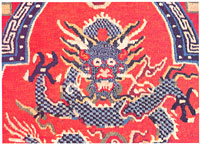
Fig.
5
|
|
The phoenix has an
intensely feminine quality. Her feathers are full of wind, and with the
dragon she depicts the cosmic dance of opposites in harmony. Scarfs or
ribbons become draped around the norbu, which comes in threes, and other
auspicious emblems. They are light, composed of air, and float. Similar
to the scarf is the cloudband; it is in effect a wisp. The mongoose descends
to vomit jewels to portray wealth. Water flows and embraces. It moves
in streams, falls in drops, sets in pools, or returns to the sky in rainbows.
Its opposite is the lotus which continually rises through the murky depths
of a pond to the surface where it blossoms.
| |
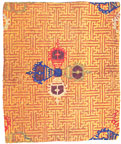 Fig.
6
Fig.
6 |
Trees may be austere
and naked or clothed with leaf, flower, and fruit. The deer represents
peace without docility. Skins of various animals are sometimes depicted
as seats. They wear a look of contentment as if they have been freed of
their mask. Conversely, skulls are dry. They do not smile but grin insanely
at the big joke. Frogs leave their chance, repetitive prints across the
fields of carpets. The incense pot, the table stand, the vase, and other
man-made things contain a sense of symmetric perfection. Smoke rises and
borders with the texture of metal wire. Knots have two main varieties:
the love knot is associated with the number six, while the knot of eternity
is squared into eights and fours. The meander "T", or Chinese
wall, is a symbol of protection, Peonies and other flowers may grow from
the most sterile support, such as a rock or geometrical border. Medallions
are the embossed stamps on the fields of carpets; they are like pictures
of a picture. Depending on the motion of the swastika, the involution
and evolution of the universe is portrayed.
 Fig.
7
Fig.
7 |
|
The Tibetan rug was
never more than what a tensioned web could net. Elaborate schemes to generate
and develop an image; complex notions and motions. What fell through the
net was objectless vision. The loom, the tools, the knotted design, and
even the weaver himself were projections of the view. Put another way,
they were projected onto the lustrous ground of continuous warp still
in the grease. It was to this view they clung so tightly, while loosening
their perspective in the impossible forms that were finally, inseparably
woven.
|






